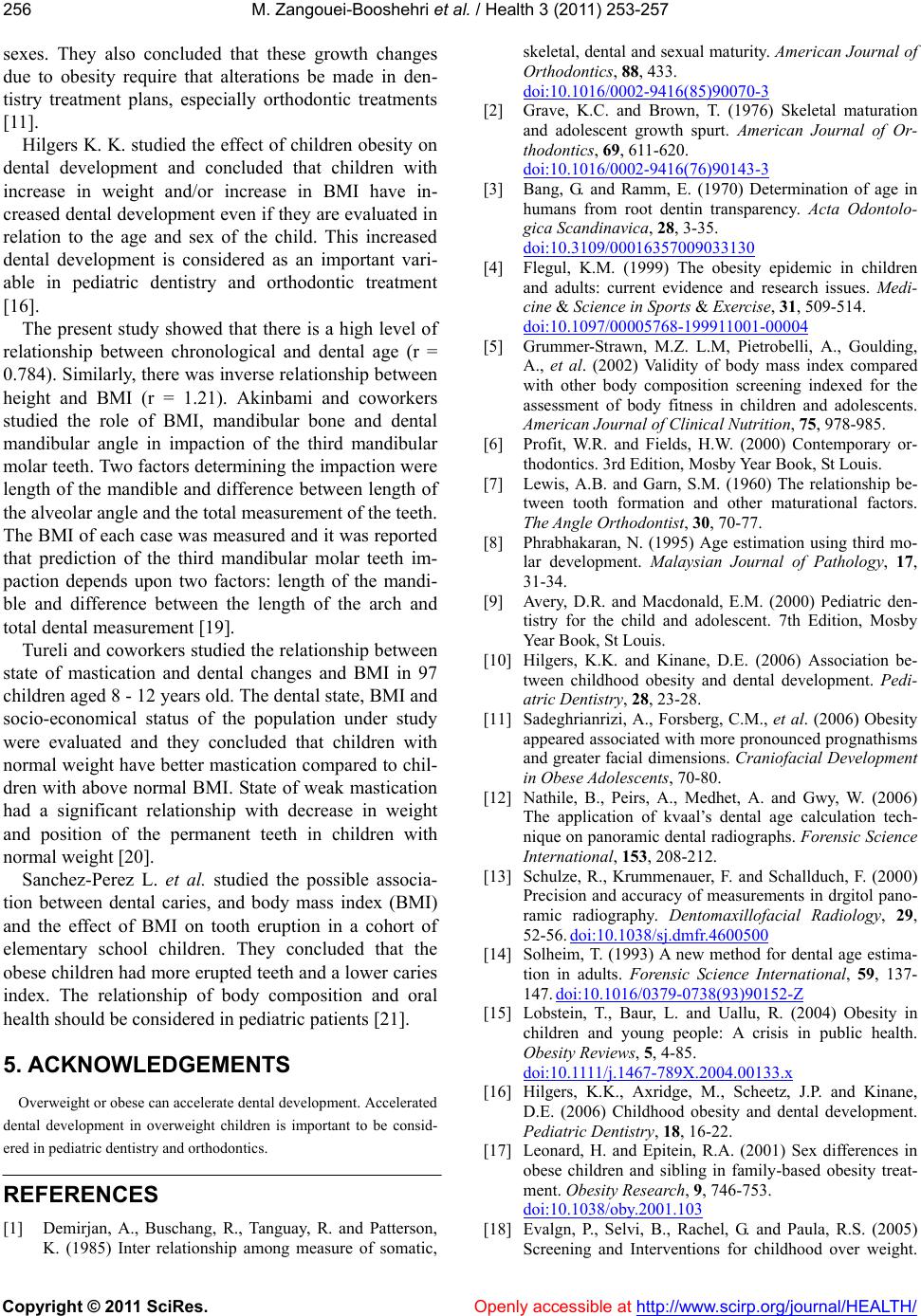
M. Zangouei-Booshehri et al. / Health 3 (2011) 253-257
Copyright © 2011 SciRes. Openly accessible at http://www.scirp.org/journal/HEALTH/
256
sexes. They also concluded that these growth changes
due to obesity require that alterations be made in den-
tistry treatment plans, especially orthodontic treatments
[11].
Hilgers K. K. studied the effect of children obesity on
dental development and concluded that children with
increase in weight and/or increase in BMI have in-
creased dental development even if they are evaluated in
relation to the age and sex of the child. This increased
dental development is considered as an important vari-
able in pediatric dentistry and orthodontic treatment
[16].
The present study showed that there is a high level of
relationship between chronological and dental age (r =
0.784). Similarly, there was inverse relationship between
height and BMI (r = 1.21). Akinbami and coworkers
studied the role of BMI, mandibular bone and dental
mandibular angle in impaction of the third mandibular
molar teeth. Two factors determining the impaction were
length of the mandible and difference between length of
the alveolar angle and the total measurement of the teeth.
The BMI of each case was measured and it was reported
that prediction of the third mandibular molar teeth im-
paction depends upon two factors: length of the mandi-
ble and difference between the length of the arch and
total dental measurement [19].
Tureli and coworkers studied the relationship between
state of mastication and dental changes and BMI in 97
children aged 8 - 12 years old. The dental state, BMI and
socio-economical status of the population under study
were evaluated and they concluded that children with
normal weight have better mastication compared to chil-
dren with above normal BMI. State of weak mastication
had a significant relationship with decrease in weight
and position of the permanent teeth in children with
normal weight [20].
Sanchez-Perez L. et al. studied the possible associa-
tion between dental caries, and body mass index (BMI)
and the effect of BMI on tooth eruption in a cohort of
elementary school children. They concluded that the
obese childr en had more erupted teeth an d a lower caries
index. The relationship of body composition and oral
health should be considered in pediatric patients [21].
5. ACKNOWLEDGEMENTS
Overweight or obese can accelerate dental development. Accelerated
dental development in overweight children is important to be consid-
ered in pediatric dentistry and orthodontics.
REFERENCES
[1] Demirjan, A., Buschang, R., Tanguay, R. and Patterson,
K. (1985) Inter relationship among measure of somatic,
skeletal, dental and sexual maturity. American Journal of
Orthodontics, 88, 433.
doi:10.1016/0002-9416(85)90070-3
[2] Grave, K.C. and Brown, T. (1976) Skeletal maturation
and adolescent growth spurt. American Journal of Or-
thodontics, 69, 611-620.
doi:10.1016/0002-9416(76)90143-3
[3] Bang, G. and Ramm, E. (1970) Determination of age in
humans from root dentin transparency. Acta Odontolo-
gica Scandinavica, 28, 3-35.
doi:10.3109/00016357009033130
[4] Flegul, K.M. (1999) The obesity epidemic in children
and adults: current evidence and research issues. Medi-
cine & Science in Sports & Exercise, 31, 509-514.
doi:10.1097/00005768-199911001-00004
[5] Grummer-Strawn, M.Z. L.M, Pietrobelli, A., Goulding,
A., et al. (2002) Validity of body mass index compared
with other body composition screening indexed for the
assessment of body fitness in children and adolescents.
American Journal of Clinical Nutrition, 75, 978-985.
[6] Profit, W.R. and Fields, H.W. (2000) Contemporary or-
thodontics. 3rd Edition, Mosby Year Book, St Louis.
[7] Lewis, A.B. and Garn, S.M. (1960) The relationship be-
tween tooth formation and other maturational factors.
The Angle Orthodontist, 30, 70-77.
[8] Phrabhakaran, N. (1995) Age estimation using third mo-
lar development. Malaysian Journal of Pathology, 17,
31-34.
[9] Avery, D.R. and Macdonald, E.M. (2000) Pediatric den-
tistry for the child and adolescent. 7th Edition, Mosby
Year Book, St Louis.
[10] Hilgers, K.K. and Kinane, D.E. (2006) Association be-
tween childhood obesity and dental development. Pedi-
atric Dentistry, 28, 23-28.
[11] Sadeghrianrizi, A., Forsberg, C.M., et al. (2006) Obesity
appeared associated with more pronounced prognathisms
and greater facial dimensions. Craniofacial Development
in Obese Adolescents, 70-80.
[12] Nathile, B., Peirs, A., Medhet, A. and Gwy, W. (2006)
The application of kvaal’s dental age calculation tech-
nique on panoramic dental radiographs. Forensic Science
International, 153, 208-212.
[13] Schulze, R., Krummenauer, F. and Schallduch, F. (2000)
Precision and accuracy of measurements in drgitol pano-
ramic radiography. Dentomaxillofacial Radiology, 29,
52-56. doi:10.1038/sj.dmfr.4600500
[14] Solheim, T. (1993) A new method for dental age estima-
tion in adults. Forensic Science International, 59, 137-
147. doi:10.1016/0379-0738(93)90152-Z
[15] Lobstein, T., Baur, L. and Uallu, R. (2004) Obesity in
children and young people: A crisis in public health.
Obesity Reviews, 5, 4-85.
doi:10.1111/j.1467-789X.2004.00133.x
[16] Hilgers, K.K., Axridge, M., Scheetz, J.P. and Kinane,
D.E. (2006) Childhood obesity and dental development.
Pediatric Dentistry, 18, 16-22.
[17] Leonard, H. and Epitein, R.A. (2001) Sex differences in
obese children and sibling in family-based obesity treat-
ment. Obesity Research, 9, 746-753.
doi:10.1038/oby.2001.103
[18] Evalgn, P., Selvi, B., Rachel, G. and Paula, R.S. (2005)
Screening and Interventions for childhood over weight.